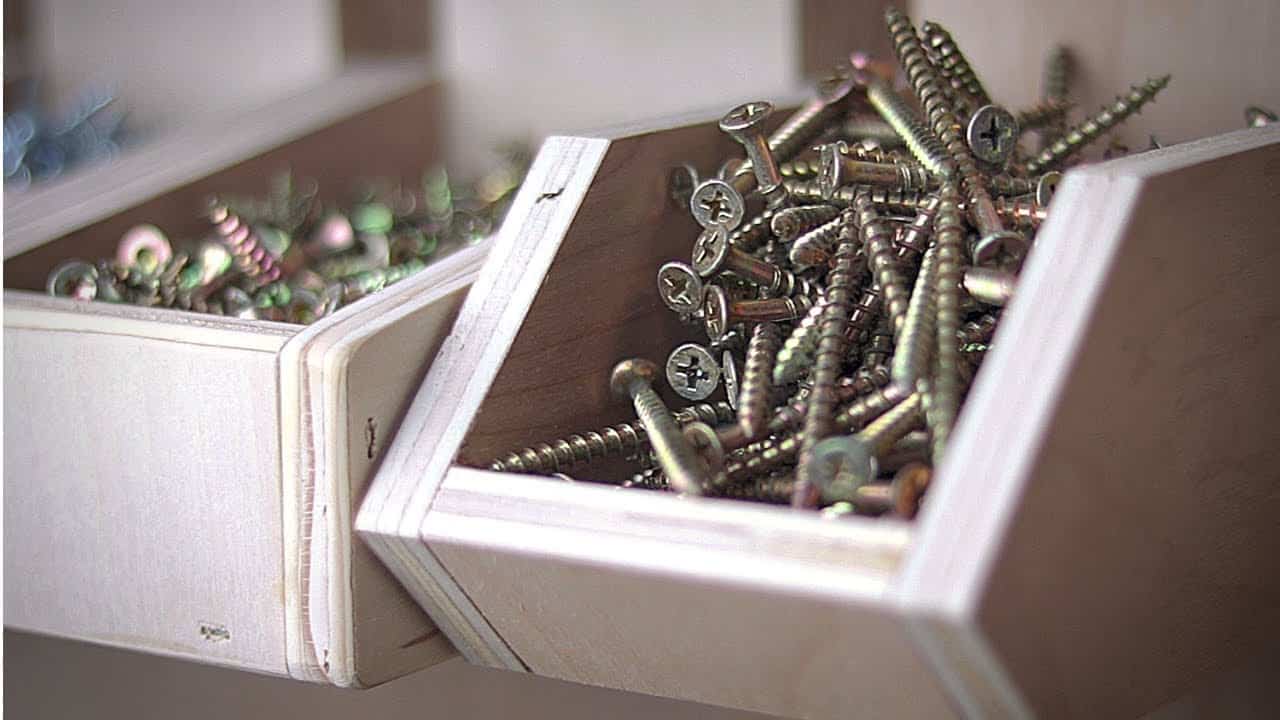This project was built and designed by Jodee from Inspire Woodcraft.
Jodee walks through a simple, repeatable approach to make small hardware bins that work with a French cleat system and improve shop organization.
The video focuses on practical techniques, quick assembly, and ways to adapt the design based on available tools and scrap material.
Watch the full video and subscribe to Jodee’s channel:
Design
The bins are deliberately simple and compact so they can be stacked or moved around the shop on a French cleat wall. The design prioritizes utility over ornamentation, making them easy to reproduce in batches and size up or down to fit different hardware.
The form is straightforward: a small front face, a back that mates with the cleat, a bottom, and two side panels, with the option to add thin dividers to separate contents. That simplicity keeps layout and cutting fast, and it makes adjusting proportions easy when using scrap stock.
Lumber Prep
Parts are cut from plywood and dimensioned to fit the intended contents rather than strict plans, so builders can adapt to what they have on hand.
Rough cutting can be done on a table saw and miter saw, and Jodee mentions a bandsaw option for shaping; an alternate miter-only approach is demonstrated later for shops without a bandsaw.
Keeping parts consistent is more important than exact measurements for this project, so marking and repeat cuts will speed up making multiples. Using leftover plywood yields an economical and lightweight bin that still handles daily shop use.
Assembly & Joinery
Jodee combines traditional wood glue with a cyanoacrylate (CA) glue and accelerator to tack parts together instantly and then reinforces the joint with staples or brad nails. That hybrid approach gives immediate handling strength and longer-term adhesion without complex joinery.
Builders can skip mechanical fasteners if preferred and rely solely on a strong glue bond, though staples or brads add confidence for bins that will be moved often. The sequence—gluing, tack with CA, then fasten—keeps assembly quick and repeatable.
Shaping & Edge Treatment
The front edges are rounded over and all corners are sanded to remove sharp edges and prevent splinters during regular use. These small shaping steps improve comfort and longevity without adding much time to the build.
Thin plywood strips can be added as internal dividers to create multiple compartments inside a single bin, increasing versatility for small parts and fasteners. The dividers are a low-effort way to tailor the interior for screws, nuts, bolts, or specialty hardware.
Using with a French Cleat and Shop Workflow
Designed to hang on a French cleat system, the bins are portable storage that can be taken from the organized wall to the workbench and back again. This mobility keeps commonly used hardware within arm’s reach and reduces downtime hunting for parts during projects.
Having several identical bins lets users standardize storage—labeling or visually grouping contents makes it faster to grab the right piece and return it to the same spot. The system supports an efficient workflow where the workspace can be reconfigured by simply moving bins around.
Final Takeaways
These hardware bins are an excellent shop-made solution for small-parts storage that emphasizes speed, adaptability, and efficient use of scrap material. The techniques Jodee demonstrates—simple joinery, instant-tack gluing, and modest shaping—are widely applicable to other small shop projects.
Builders can easily adapt the size, fastening method, and interior layout to suit their needs, making this a practical improvement for any workshop using a French cleat system. The result is tidy, mobile storage that keeps essential hardware close at hand and simplifies daily shop work.
Support Jodee by visiting his online store here: https://inspirewoodcraft.com/collections/all.
